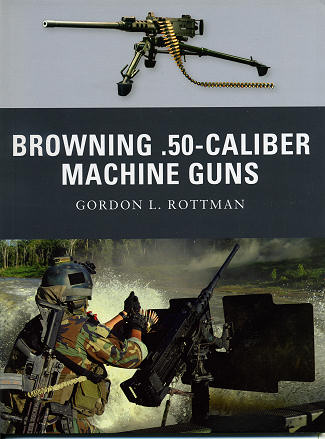 It is hard to
think of any weapon, other than a knife, that has been in military use since the
1930s and has still not been replaced. This weapon was used extensively by the
US and Allies in WWII and even today is probably the most used of its type in
the world.
It is hard to
think of any weapon, other than a knife, that has been in military use since the
1930s and has still not been replaced. This weapon was used extensively by the
US and Allies in WWII and even today is probably the most used of its type in
the world.
I'm referring to the Browning .50 caliber machine gun.
This gun was initially developed to provide a high
powered machine gun to be used against long range targets like tanks and
aircraft. Though the desire for the weapon and initial design started with WWI,
it wasn't until the 1930s that it was put into service with the US military.
Then it was for the initial stated purpose as back then, the power of the .50
caliber bullet was enough to punch a hole through tank armor and to bring down
the planes of the era. In fact, the gun is probably best known to most readers
for its use in aircraft as it became the standard aviation gun of the 1940s.
The development of the gun was such that it was
extremely robust, was able to be easily modified for a variety of purposes,
including both manual and electric firing as well as being able to be belt fed
from either side of the gun, something important for aviation use. It also had
to be easy to repair and relatively easy to operate. And it is.
Used in both air-cooled and water-cooled set-ups, it is
arguably one of the five most important US weapons of WWII and Korea. Despite
efforts to replace it with new weapons systems, the M2 .50 caliber gun is still
one of the most important crew operated weapons in the US inventory. While it
has been upgraded, it has not been replaced and from the look of things, won't
be for quite a while. It is just too good a weapon.
In this book on the Browning, author Gordon Rottman covers the
development, early years and modifications done to the gun. It also covers the
use of the gun by the US military in various wars over the last 70 years. Finally, a look at the
impact of the gun is covered as well as a look at those systems designed to
replace it and why they did not.
It is a superb book that is fascinating to read. A great
addition to this new series and one that I am positive you will enjoy. Highly
recommended.
November 2010
For more on the complete line of Osprey books,
visit www.ospreypublishing.com
or contact them at Osprey Direct, PO Box 140, Wellingborough, Northants,
NN8 2FA, UK. In the US, it is
Osprey Direct at 44-02 23rd St, Suite 219, Long Island City, NY 11101., where you can
get a catalogue of available books.
If you would like your product reviewed fairly and quickly, please
contact
me or see other details in the Note to
Contributors.
 It is hard to
think of any weapon, other than a knife, that has been in military use since the
1930s and has still not been replaced. This weapon was used extensively by the
US and Allies in WWII and even today is probably the most used of its type in
the world.
It is hard to
think of any weapon, other than a knife, that has been in military use since the
1930s and has still not been replaced. This weapon was used extensively by the
US and Allies in WWII and even today is probably the most used of its type in
the world.